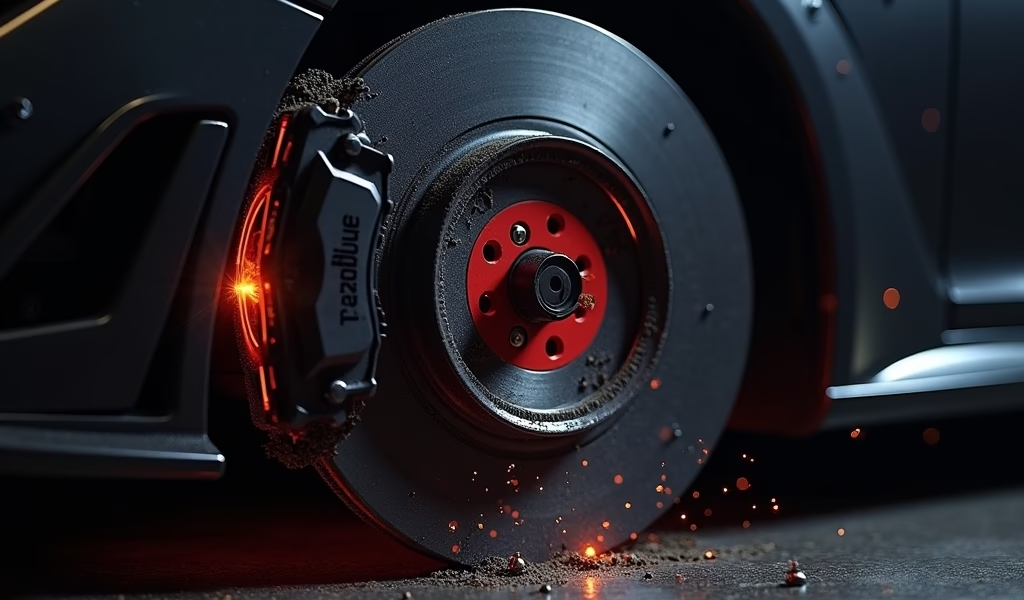Overview
This article provides five essential maintenance techniques for carbon ceramic brake discs, including regular inspection, proper breaking-in, temperature management, specialized cleaning methods, and appropriate storage practices. These premium components require specialized care to maximize their longevity and performance, potentially lasting 100,000+ miles when properly maintained, despite their high replacement cost of $4,000-$15,000.
Table of Contents
- What Are Carbon Ceramic Brake Discs?
- Hack 1: Regular Inspection – Your First Line of Defense
- Hack 2: Proper Breaking-in Technique – Setting the Foundation
- Hack 3: Temperature Management – Finding the Sweet Spot
- Hack 4: Specialized Cleaning Methods – Gentle Care for Premium Components
- Hack 5: Storage and Seasonal Transitions – Protecting Your Investment
- Conclusion
- Frequently Asked Questions
What Are Carbon Ceramic Brake Discs?
Carbon ceramic brake discs represent the pinnacle of braking technology in the automotive world. As a master technician who’s worked on everything from daily drivers to hypercars, I’ve seen firsthand how these remarkable components transform a vehicle’s stopping power and performance.
Unlike conventional cast iron discs, carbon ceramic brake discs are crafted from a specialized composite material that combines carbon fibers with ceramic compounds, then baked at temperatures exceeding 3,000°F. This creates a braking surface that’s not only incredibly resistant to heat fade but also significantly lighter – often 50-70% less weight than their cast iron counterparts.
This weight reduction isn’t just about bragging rights. It translates to reduced unsprung mass, which improves handling, acceleration, and fuel efficiency. Plus, when properly maintained, these premium discs can last up to 100,000 miles or more – often outlasting the vehicle itself.
But here’s the catch – replacing a set can cost anywhere from $4,000 to $15,000, depending on your vehicle. That’s why proper care is essential. Let me share five proven maintenance hacks I’ve developed over two decades in the performance automotive field to help you protect this significant investment.
Hack 1: Regular Inspection – Your First Line of Defense
Carbon ceramic brake discs don’t communicate wear in the same way traditional discs do. You won’t see the obvious rust or scoring that makes iron disc assessment straightforward. Instead, you need to know what subtle signs to look for.
I recommend inspecting your carbon ceramic discs at least monthly or every 1,000 miles. Remove a wheel (or use a good inspection mirror) and check for:
- Fine surface cracking (hairline cracks that form a “crazing” pattern are normal)
- Deep structural cracks (especially those running to the disc edge – these need immediate attention)
- A consistent light gray surface color (this indicates normal wear)
- Glossy or glazed patches (potential signs of overheating)
- Edge chipping or material flaking (may indicate impact damage)
Pay special attention to the transition area between the friction surface and the mounting bell. This junction experiences significant thermal stress and is often the first place structural issues appear.
While you’re there, check the brake disc ventilation channels for any debris buildup. These internal cooling passages are crucial for temperature management and can sometimes collect road debris that reduces cooling efficiency.
Developing this inspection habit early will help you catch minor issues before they become major expenses. Remember, when it comes to carbon ceramics, an ounce of prevention is worth several thousand dollars of cure.

Hack 2: Proper Breaking-in Technique – Setting the Foundation
The first few hundred miles with new carbon ceramic brake discs are critical to their long-term performance. Breaking them in properly creates an even transfer layer of friction material across the disc surface – think of it as conditioning the surface for optimal performance.
This bedding-in process isn’t complicated, but it does require some discipline. Here’s the procedure I recommend to my customers:
- Find a safe, open road with minimal traffic
- Perform 8-10 moderate braking events from 60 mph down to about 20 mph
- Allow 30-45 seconds of gentle driving between each braking event for cooling
- Finish with 2-3 slightly harder braking events from 70 mph to 20 mph
- Drive gently without hard braking for about 10 minutes afterward to allow proper cooling
The key is consistency and moderation. You’re not trying to test the limits of your brakes here – you’re establishing a foundation for future performance. Avoid coming to a complete stop during this process if possible, as sitting with hot pads against the discs can create uneven material transfer.
For the first 300-500 miles after installing new carbon ceramic discs, try to avoid situations requiring extreme braking. This means no track days, mountain canyon carving, or towing heavy loads during the break-in period. A bit of patience now will reward you with exceptional performance for thousands of miles.
While working with the disc brake caliper system, remember that proper pad and caliper alignment are crucial for even wear patterns. Even the most expensive carbon ceramic discs will wear prematurely if paired with improperly functioning calipers.
Hack 3: Temperature Management – Finding the Sweet Spot
One of the most misunderstood aspects of carbon ceramic brake care is temperature management. Unlike iron discs, which perform well from cold, carbon ceramics have a more complex relationship with heat. They’re designed to operate in a specific temperature window, and keeping them there is key to both performance and longevity.
The truth is, carbon ceramic discs actually perform best when warm. At cold temperatures, they can exhibit a phenomenon known as “cold judder” – a grabby, uneven braking feel that’s both unpleasant and potentially damaging if you’re braking aggressively.
Here’s my temperature management playbook:
- Begin each drive with gentle, progressive brake applications to gradually warm the system
- Avoid sitting with your foot on the brake pedal, which creates hot spots
- After hard driving, perform a cool-down period of gentle driving without stopping completely
- Never spray cold water on hot carbon ceramic discs – the thermal shock can cause cracking
According to Brembo’s technical resources, carbon ceramic discs can withstand temperatures up to 1,600°F (870°C) – far higher than iron discs. However, it’s the rapid temperature changes that cause problems, not the absolute temperature itself.
During track days or spirited mountain driving, your brakes will naturally get very hot. That’s what they’re designed for. The key is allowing a proper cool-down period afterward rather than stopping immediately. I recommend a gentle “cool-down lap” at the track or 5-10 minutes of light braking before parking.
This approach ensures your discs cool gradually and evenly, preventing warping and extending their service life considerably. Think of your carbon ceramic brakes like a high-performance athlete – they need a proper warm-up and cool-down to perform at their best.
Hack 4: Specialized Cleaning Methods – Gentle Care for Premium Components
Carbon ceramic brake discs demand cleaning techniques as specialized as the discs themselves. The wrong products or methods can actually damage these premium components, shortening their lifespan and compromising performance.
I’ve seen too many enthusiasts treat their carbon ceramic discs like conventional rotors, using harsh chemicals and abrasive tools that do more harm than good. Let me share what I’ve learned from years of maintaining these sophisticated systems:
- Use only pH-neutral cleaners specifically formulated for ceramic brakes
- Apply cleaner with soft microfiber cloths rather than brushes
- Clean regularly to prevent brake dust buildup (which becomes more difficult to remove over time)
- Rinse thoroughly with clean water and allow to air dry completely
- Consider applying a specialized ceramic brake protectant after cleaning
What’s equally important is knowing what to avoid. Never use acidic wheel cleaners, which can etch the ceramic surface and compromise its structural integrity. High-pressure washers can force water and contaminants into the carbon fiber matrix, while abrasive brushes can create micro-scratches that collect brake dust and affect performance.
Measuring your rotor hat height periodically can also help you track wear patterns and ensure your cleaning isn’t causing any unintended damage. Excessive or uneven wear might indicate that your cleaning technique needs adjustment.
For those who drive in winter conditions where road salt is used, more frequent cleaning becomes essential. Consumer Reports recommends washing your vehicle (including brake components) at least every ten days during winter to prevent salt damage, which applies doubly for performance braking systems.
A quarterly deep cleaning regimen keeps your carbon ceramic discs performing at their peak while protecting surrounding components from corrosive brake dust. Remember, these discs are designed to last the lifetime of your vehicle when properly maintained – and proper cleaning is a cornerstone of that maintenance.

Hack 5: Storage and Seasonal Transitions – Protecting Your Investment
Whether you’re storing a vehicle for winter or simply parking it for an extended period, proper preparation of carbon ceramic brakes is essential. These high-performance components need special attention during downtime to ensure they’re ready to perform when you return to the driver’s seat.
Over the years, I’ve developed a systematic approach to storage that preserves these premium braking systems:
- Clean thoroughly before storage using the gentle methods described earlier
- Ensure brakes are completely dry to prevent moisture accumulation
- Apply a light coat of specialized brake protection product (not regular wax or sealant)
- When possible, avoid engaging the parking brake for long-term storage
- Use wheel chocks as an alternative to the parking brake
The parking brake recommendation often surprises owners, but there’s solid science behind it. When engaged for months at a time, parking brakes can create uneven material transfer between the pads and discs, potentially leading to vibration when you resume driving.
For seasonal transitions, particularly from winter to spring, take these additional steps:
- Inspect all mounting hardware for corrosion (the brackets and bolts can rust even if the discs don’t)
- Check cooling vanes for debris that might have accumulated during storage
- Perform several light braking events to clean the disc surface before spirited driving
- Be particularly mindful about gradual warm-up after extended storage
If your vehicle has been sitting for months, the brake discs develop a thin oxidation layer on the surface – even carbon ceramics aren’t completely immune to this. The National Highway Traffic Safety Administration (NHTSA) emphasizes the importance of checking all safety systems after extended storage, with brakes being a top priority.
While carbon ceramic discs themselves are corrosion-resistant, the aluminum mounting bells and steel hardware are not. Any corrosion here can transfer to the carbon ceramic surface or cause uneven disc mounting, affecting braking performance. Addressing these issues before they become problematic saves both money and potential safety concerns.
Conclusion
Carbon ceramic brake discs represent a significant investment in your vehicle’s performance and safety. With replacement costs often exceeding $10,000, proper maintenance isn’t just recommended – it’s essential financial protection.
The five care hacks I’ve shared come from decades of hands-on experience with these premium components. Regular inspection, proper breaking-in, temperature management, specialized cleaning, and careful storage practices will help ensure your carbon ceramic brake discs deliver exceptional performance throughout your ownership experience.
Remember that these sophisticated components demand more attentive care than conventional brake discs, but they reward that attention with unmatched performance, reduced weight, and potentially lifetime durability.
The most important takeaway is consistency. Establish these maintenance habits early and practice them regularly. Your carbon ceramic brake discs are engineered to perform under the most demanding conditions – give them the care they deserve, and they’ll reward you with fade-resistant stopping power mile after mile.
Have you implemented any of these care techniques for your performance braking system? I’d love to hear about your experience in the comments below.
Frequently Asked Questions
How long do carbon ceramic brake discs typically last?
With proper care, carbon ceramic brake discs can last 100,000+ miles or even the lifetime of the vehicle. Their exceptional durability is one of the primary benefits justifying their premium price.
Are carbon ceramic brakes worth the extra cost?
For performance enthusiasts and those who drive their vehicles hard, the improved fade resistance, reduced weight, and extended lifespan make them worthwhile. Daily drivers who rarely push their vehicles may not see sufficient benefit to justify the cost.
Can carbon ceramic brake discs be repaired if damaged?
Unlike conventional rotors, carbon ceramic discs generally cannot be machined or repaired once damaged. This makes preventative maintenance even more critical for protecting your investment.
Do carbon ceramic brakes perform poorly when cold?
Carbon ceramics typically need warming up to reach optimal performance. They may exhibit some “cold judder” or reduced initial bite when completely cold, which is why gradual warm-up is recommended.
Can I use regular brake cleaners on carbon ceramic discs?
No, regular brake cleaners may contain chemicals harmful to the ceramic matrix. Only use pH-neutral cleaners specifically formulated for carbon ceramic components to avoid damage.

